| |
"I've always had this idea to have two characters swapping place. Their sudden and unexpected proximity, their coming together, acts as a trigger for big change inside both of them. This was an extreme case. However in the context of a western it was acceptable and even realistic." |
| |
Director Sergio Sollima |
When you think about it, the term 'Spaghetti Western' is just a weeny bit insulting. After all, we don't refer to the films of the French New Wave as Frog Leg Dramas or those big Hollywood summer movies as Hamburger Blockbusters. It's perhaps no surprise then that the phrase was originally coined by American critics in the 1960s as a derogatory term to collectively dismiss a new style of low budget, Italian-made westerns. But it's one of those labels that quickly stuck and has now become the accepted term – even within the Italian film industry – for a particular type of western that has for some time been recognised as a fully fledged sub-genre, one with its own instantly recognisable codes and conventions.* It has even given birth to its own filmmakers and stars, a few of whom have achieved international recognition beyond the genre in which they rose to fame. The most famous of the former has to be Sergio Leone, and with good reason – his genre-defining Dollars trilogy was almost single-handedly responsible for introducing the genre to the world at large, while his 1968 Once Upon a Time in the West breathtakingly demonstrated that the Spaghetti Western could be synonymous with great film art.
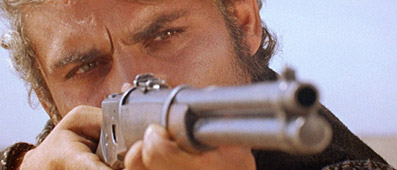
But what about the other key genre filmmakers, such as Enzo Barboni (director of the Trinity films), Enzo G. Castellari (One Dollar Too Many; Keoma), Gianfranco Parolini (the Sabata trilogy), Tonino Valerii (A Reason to Live, A Reason to Die; My Name is Nobody) Sergio Corbucci (Django) and Sergio Sollima (The Big Gundown)? Their fame within the genre is almost as great that of Leone, but their achievements often go unappreciated by the wider film-going public. Part of the problem lies with the genre in which they made their names, which like martial arts cinema has its own specific fan base and is still often dismissed by those who are not part of it. And that's a real shame, as there are hugely entertaining and genuinely great films nestled within the genre's confines, ones that you may not previously have heard of or have seriously considered watching. And you should. You really should. And you'll find no better argument for why than Sergio Sollima's superb 1967 Faccia a faccia [Face to Face].
Having made the above statement, I am well aware that those who believe that such films are made to a strict formula will find plenty to support that prejudice in this film's opening minutes. We start in a classroom of a New England school, where a meek and tubercular professor with the very American name of Brad Fletcher – played by the very Italian-looking Gian Maria Volonté (the blue-eyed wonder who played 'The Indian' in Leone's For a Few Dollars More) – sets off for Texas, whose sunshine and heat he hopes will be beneficial to his health. This is followed by the sort of multicoloured graphical title sequence you'll only find on spaghetti westerns, accompanied by an arresting but genre-specific score by everyone's favourite Italian western composer, Ennio Morricone. And as this is the original Italian language version, these would-be Americans don't speak a word of English. But it's once the professor is installed in his new location that the deviations from the norm really begin.
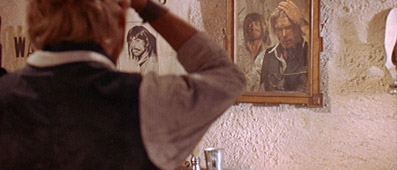
Brad is enjoying the warmth and hospitality of a quiet Texas hamlet when a posse arrives with a prisoner in tow, a bandit named Solomon 'Beauregard' Bennett (played by genre icon Tomas Milian), the former leader of the notorious but now disbanded Wild Gang. In spite of the man's fearsome reputation, the compassionate Brad insists on offering him water and is taken hostage for his trouble. Beau escapes with Brad in tow, but collapses from his injuries when the stagecoach he hijacks crashes and flips over. When he wakes, he is surprised to find that instead of running away, Brad has done his best to get him to safety. Why? Because Brad is a genuinely nice guy who believes that even the nastiest rogue deserves to be decently treated.
As you may have already gathered, Brad is not your standard Italian western lead. And he doesn't become one, at least not in the in the usual mould or at the expected stage of the narrative. You keep waiting for him to be transformed into a pistol-packing hard man driven to revenge by some callous act of violence or humiliation against his person, but it just never happens. Indeed, Brad is about as far from the amoral Italian western anti-hero as you could hope to find – he always prefers the non-violent approach, he's never held a gun, and he weeps with horror at the prospect of cutting a bullet from Beau's injured body. His sensitivity begins to rub off on his hard-nosed companion, who after slapping Brad for some critical remarks, comforts him and tenderly suggests that this is no place for a man of his sensitivity and that he should head back to New England. Surprisingly, Brad agrees and the two make their way to the wonderfully named Purgatory City, where Beau goes in search of a former compadre and the professor awaits the arrival of the train home. End of story, right? Not by a long chalk.
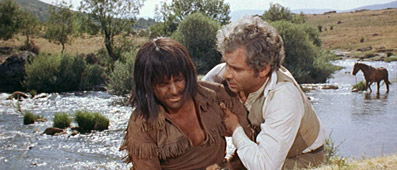
In spite of Beau's faults, he and Brad have become friends, and when Beau plonks himself down on a main street porch to await the arrival of a band of miscreants, Brad wanders over to offer moral support and ends up saving his life. The seed is sown, and just as Brad is about to board the train home he has a sudden change of heart and instead rides off with Beau and joins him in his quest to reunite the former gang members. The turning point for both men and their increasingly close bond comes when the reassembled gang return to their home town of Pietra di Fuouco, an impoverished, mixed-race community of "hunters with no buffalos, cowboys with no herds, and prospectors with no gold." The whole thing is a revelation for city-boy Brad. "I've never seen people so real," he remarks to one of Beau's comrades, "people so free and so happy." It's here that his eyes are first opened to the idea that Beau may well be an outlaw with a purpose, a revolutionary leader who steals not for personal gain but to procure food and materials for his struggling people.
It's shortly after this that the story takes its most intriguing turn. Just as Beau begins to reveal the caring underbelly to his tough guy persona, so Brad becomes seduced by the way of the gun. What comes as a surprise, despite earlier indicators that this might eventually occur, is the abruptness of his transformation. Mesmerised by the site of a woman dressing after bathing, he follows her from the river and instead of approaching her in his usual apprehensive manner, begins smacking her around as a brutal foreplay to seduction. It's an action that prompts her to dump her current boyfriend – long standing gang-member and hard man Vance (Nello Pazzafini) – and shack up with the new fella. And while Brad may be the underdog in the fist-fight with Vance that follows, his newly discovered cold streak enables him to best his opponent by repeatedly banging his head against a rock. A short while later he's making plans for the gang that look set to usurp Beau's position as its leader.
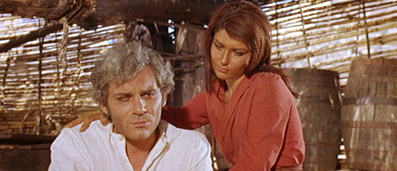
If the plot is unusual by genre standards then so is the level of cinematic restraint. There is no editing to sound effects, no attention-grabbing crash zooms and no stylised organisation of characters within the scope frame – even the familiar close-ups of eyes during stand-offs are carefully rationed. This is story-centric filmmaking at its most unobtrusively effective. When Sollima does gently flex his directorial muscles then it's always with purpose, as when he unexpectedly switches focus from the Purgatory City gunfight to the faces of the two bureaucrats who engineered the whole thing as they watch from a balcony window like Roman dignitaries in prime seats at the Colosseum. Sollima's scene-staging skills hit a creative peak with bank robbery devised by the born-again Brad, which initially unfolds in sync with Brad's verbal outline of how his plan will work (a technique that has been reused repeatedly since by caper movies the world over). It then plays tension games with the efforts of undercover Pinkerton man Siringo (William Berger) to alert the authorities, which concludes in a pandemonium of gunfire that briefly foreshadows the opening sequence of Peckinpah's genre-changing The Wild Bunch.
But Faccia a faccia is far more than the sum of its impressive parts. The above mentioned scenes – which should also include a climactic reunification that sees Beauregard and Brad take on a small army of lawmen – are not so much standouts as typical of the film as a strikingly well-balanced whole. To discover a genre work of this period so driven by story and character is thrilling enough, but to find one that does so in such consistently thoughtful and entertaining fashion, and with this degree of social, thematic and even political layering, is a hugely satisfying cinematic treat.
While not as pristine as some Eureka releases – a fair amount of dust remains and there is occasionally some minor but visible picture jitter – the 2.35:1 anamorphic transfer here is still pretty damned impressive, particularly in the level of detail and a well balanced contrast range that makes few if any sacrifices to keep the black levels solid. The colour palette often has a slightly earthy hue, which may be down to the age of source materials, but blue skies are not compromised and the bright colours of the opening titles are richly reproduced.
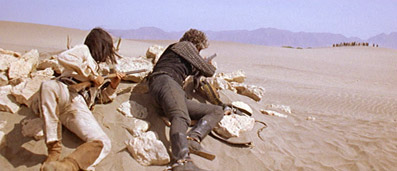
The Dolby mono 2.0 Italian soundtrack is clean of damage and background hiss or crackle, but very narrow in its dynamic range, having almost no bass and sometimes crisp treble, particularly on any metallic noises.
Interview with director Sergio Sollima (16:10)
Director Sollima discusses the concept of the film, its characters, the casting of the leads, their differing acting styles and initial hostility towards each other (which he believed helped the film and indeed saved him having to engineer the conflict himself) and his admiration for Morricone, who in his view looks more like a bank clerk than a musician.
Theatrical Trailer 1 (2:47)
A trailer that sells the film very much in Spaghetti Western terms, complete with an overuse of the same two graphical portraits of its leading men. The lack of dialogue presumably made foreign sales a little easier.
Theatrical Trailer 2 (3:08)
An alternative version of the same, but more clearly targeted at the English-speaking market (the credits are in English and the film wears its English title of Face to Face).
Booklet
Jacketed by poster artwork, the bulk of the booklet consists of an enjoyable essay on the film by Howard Hughes, not the germ-free billionaire but the author of Once Upon a Time in the Italian West: The Filmgoers' Guide to Spaghetti Westerns and Cinema Italiano: The Complete Guide from Classics to Cult. Also included are credits for the film, colour-treated publicity stills, and the usual advice on how to set up your TV to see the film in its correct aspect ratio.
Atypical of the genre in style, character arcs and story content, Faccia a Faccia is a too rarely seen example of the Spaghetti Western at close to its best, shining in the purposeful restraint of Sollima's direction, Morricone's typically distinctive score, the identity exchange concept at the heart of the story (something that would also be central to Donald Cammell and Nic Roeg's Performance three years later), and a pair of winningly enigmatic performances from Gian Maria Volonté and Tomas Milian. A solid transfer, the director interview and the always welcome booklet make this another most welcome and must-have Eureka release. Recommended.
|